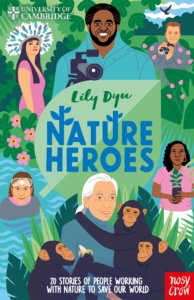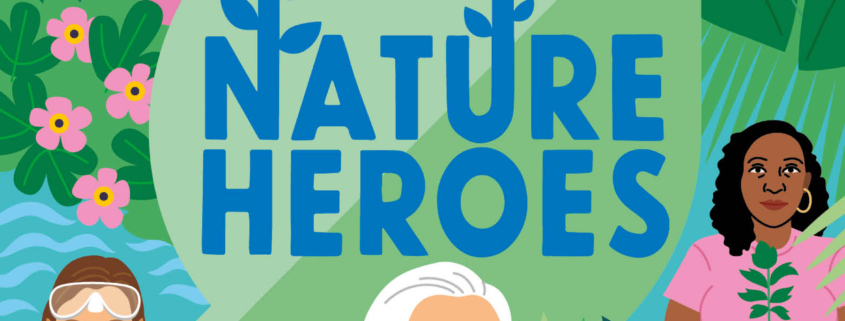Nature Heroes by Lily Dyu
Today we welcome Lily Dyu to the blog sharing insights into Nature Heroes, a book featuring inspiring people making positive changes to the environment.

Psychotherapist and eco-anxiety expert Caroline Hickman says that when talking to children about the climate and nature crises, it’s crucial to balance bad news with good. I often wish adults would apply this advice to our own information consumption too. News reporting is generally negative and can leave us all feeling hopeless, despairing and wondering “what’s the point in trying?”.
My books in Nosy Crow’s ‘Heroes’ series seek to address that media imbalance by shining a spotlight on inspiring individuals making positive change for our planet. Seeking out such stories can give us a more accurate picture of the world today without denying that there are awful things happening. And by sharing them, I want to help transform children’s eco-anxiety into hope, agency and action.
My first book Earth Heroes (2019) was about many of our climate and environmental issues alongside their solutions – from Stella McCartney’s work to “fix the fashion industry” to teenage sisters Isabel and Melati Wijsen’s activism to ban single-use plastic on Bali. A special, extended paperback edition of Earth Heroes will be published next year to celebrate Sir David Attenborough’s 100th birthday, so I’ve had the fascinating task of revisiting the stories and seeing what the heroes have achieved over the last few years – it’s been an extremely hopeful and positive exercise.
My new book Nature Heroes, published in partnership with Cambridge University, focuses on the destruction and loss of biodiversity which often receives less attention than climate change. This collection of short stories includes a ‘biodiversity’ of topics from naturalist Jane Goodall, protecting our wild chimpanzees, and ‘Gangsta Gardener’ Ron Finley, planting food verges in South Central Los Angeles, to TV presenter Chris Packham, campaigning for our wild world, and surfer Titouan Bernicot, farming and restoring corals.
Researching and writing Nature Heroes was a massive undertaking. I interviewed most of the subjects and, in preparation, immersed myself in their worlds – reading books, blogs, interviews, watching videos, and listening to podcasts while out running. Speaking to these extraordinary people was a huge privilege and one of the joys of writing about real lives.
Then it’s onto the writing. Usually, the trickiest task is choosing an opening scene to draw readers into the story. These are narratives, interweaving pertinent science,
history and explanations for young readers where necessary. This can be really challenging: one of the hardest pieces to write required explaining ‘regenerative farming’ (a type of farming focused on restoring soil health) to young readers. This is difficult to explain even to adults and by the time I had editor sign-off, I’d exceeded 20 drafts!
If I didn’t get to interview the subject, I imagined what it’s like to be in their shoes, and to bring the stories to life, these sometimes have imagined scenes. Where possible, the story was sent to the subject for fact checking. And a science communication consultant from Cambridge University (the brilliant Shelley Bolderson) also conducted a very thorough fact check. I didn’t envy her job. Her eagle eyes spotted the smallest of details, down to my “night sky pricked with a billion stars” in an Arctic story. She suggested an amend, pointing out that there are actually fewer than 10,000 stars visible to the naked eye!
Writing this book has given me much hope for the natural world, especially learning about John D Liu – the filmmaker turned ecologist who shows how it’s possible to restore large-scale damaged landscapes and ecosystems. It’s the message that I took from his story that stuck with me the most and that I want to leave you with – because it is possible to restore our Earth then we must!
Nature Heroes by Lily Dyu, illustrated by Jackie Lay (£9.99, Nosy Crow) available now.



